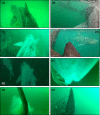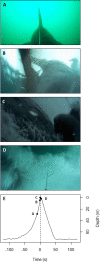Basking shark sub-surface behaviour revealed by animal-towed cameras
- PMID: 34320007
- PMCID: PMC8318306
- DOI: 10.1371/journal.pone.0253388
Basking shark sub-surface behaviour revealed by animal-towed cameras
Abstract
While biologging tags have answered a wealth of ecological questions, the drivers and consequences of movement and activity often remain difficult to ascertain, particularly marine vertebrates which are difficult to observe directly. Basking sharks, the second largest shark species in the world, aggregate in the summer in key foraging sites but despite advances in biologging technologies, little is known about their breeding ecology and sub-surface behaviour. Advances in camera technologies holds potential for filling in these knowledge gaps by providing environmental context and validating behaviours recorded with conventional telemetry. Six basking sharks were tagged at their feeding site in the Sea of Hebrides, Scotland, with towed cameras combined with time-depth recorders and satellite telemetry. Cameras recorded a cumulative 123 hours of video data over an average 64-hour deployment and confirmed the position of the sharks within the water column. Feeding events only occurred within a metre depth and made up ¾ of the time spent swimming near the surface. Sharks maintained similar tail beat frequencies regardless of whether feeding, swimming near the surface or the seabed, where they spent surprisingly up to 88% of daylight hours. This study reported the first complete breaching event and the first sub-surface putative courtship display, with nose-to-tail chasing, parallel swimming as well as the first observation of grouping behaviour near the seabed. Social groups of sharks are thought to be very short term and sporadic, and may play a role in finding breeding partners, particularly in solitary sharks which may use aggregations as an opportunity to breed. In situ observation of basking sharks at their seasonal aggregation site through animal borne cameras revealed unprecedented insight into the social and environmental context of basking shark behaviour which were previously limited to surface observations.
Conflict of interest statement
Since the funder, NatureScot, is not a commercial organisation, we do not have any commercial affiliations. This does not alter our adherence to PLOS ONE policies on sharing data and materials.
Figures







References
Publication types
MeSH terms
Associated data
LinkOut - more resources
Full Text Sources

